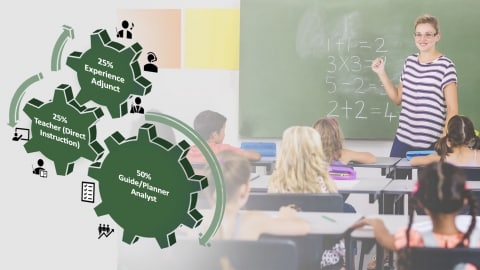Everything changes. And Technology changes everything. In education like everywhere else, the way that products are delivered (in this case, learning) is undergoing a seismic shift.
Research has been studying two things: 1) what technology can do and is already doing in many industries as well as state-of-the-art software for learning, and 2) where public education has failed, areas of success in public education and the rising demand for choice.
Our prediction for what will happen as these two things meet head-on is that teacher jobs are going to change dramatically. Also, there will be more employment, not less, but some of the roles will change. The first thing to come to grips with is the fact that the arguments about choice and teacher-to-administrator ratios are based on existing whole-group-by-age-batch and classes, specifically the classroom; they don’t acknowledge the fact that there is a different way to think about all of it now that tech and sophisticated algorithms are on the scene. There’s more to this discussion, but the top-line rough estimates are that the 3.3 million-or-so K-12 teaching jobs will eventually change roughly as follows:
50 percent as Teacher-Guides/Planners
Approximately 50 percent of teaching jobs will go into prep and analytics to provide totally personalized learning pathways. This lesson administration work with a bit of curation embedded in it is akin to personal shoppers/counselors, but for fine detail adapted to an individual’s learning style. The role will get into the deep use of analytics showing what a student may be missing in the length of time it takes them to complete a task, what quizzes and tests reveal, cross-analysis of their interests and more in order to adjudicate next steps. This is because the whole-group structure of teaching is being disintermediated by a tidal wave of great software complete with animations and algorithms that is slowly creeping into schools to replace the rather flat documents and boring slide shows that were the first stage of the digital transition.
This moves subject expertise into a “back office” function and can be done from anywhere, untethering this role from place. A portion of this work may be outside support services contracted with schools or districts. It will be a natural outgrowth of an already-existing tiered structure of top-level overall curriculum planning that dovetails down into individual courses planned by teachers. Courses in the future will be modularized and use courseware and other digital pieces intersected with live teaching. This type of redeployment of labor will blur the old ideas of teacher-administrator ratios because this role and the others predicted largely remove the classroom structure. The same thing happened to banking clerks, all parts of labor in the manufacturing industries, the taxi and transportation industry, all of the goods retail industry (Amazon), most of the book publishing labor, and it wiped out almost 100 percent of the travel agent industry. Education won’t lose jobs, but it will need to morph some jobs into new functions, disassembling roles and institutional structure, and to reassemble into new roles and a distributed structure. It already has, with some of those jobs leaving the public sector to go to private software publishers and services of all kinds; plus is utilizing global freelancing of highly specific expertise in the same way higher education did years ago and the software development industry went global-freelance.
The mass media will make a lot of people believe that the ensuing union fights and strife in the education industry is all bad and everything must go back to the way it used to be. They will cite the mass layoffs that are sure to come, as some have already happened when cities closed down whole schools due to very little enrollment or their recent pay hike for teachers proved to take them over budget and they had no choice. Or that pension costs now suck up over 75 percent of incoming revenue and politicians are beginning to help push choice just to ensure there will be any surviving structure as costs crush them and the open market promises to deliver at a fraction of their normal costs. Stories made to grab emotional reaction will leave millions of Americans thinking the end is near for public education, but with some reframing of thought about how schools will adapt around new cultural realities that will be far from true.
25 percent Teacher (Direct Instruction)
Approximately 25 percent will be in traditional lecturing, direct instruction, and a modified all-subject homeroom type classroom, plus labs of all kinds, sports fields and office one-on-one subject-expertise meets. This role monitors live on-site work in physical schools as scheduled by planners predicting which cohort of students is about to arrive at a needed lecture moment (like Uber schedules you with a driver). The teacher may rotate in for certain live instruction and do other live instruction over the internet on-demand. It will still be the best-of teaching skill. A portion of this work may be free-lancers or multi-school shared resources for one-off services who travel to do scheduled labs, lectures, etc.
25 percent Experience Adjunct
Approximately 25% will be para-professionals possibly mixed with fully credentialed teachers doing the following:
• Online support/chat-window or conference, either employed by a school or by a courseware company contracted with the school or via a student-purchased subscription. This is already a significant growth of jobs and is technically fully untethered from in-building work.
• Staging for the direct instruction teachers such as gathering the science lab materials needed before instructor and students arrive, plus other small and large group project-based learning duties. Note that these first two bullet points are ramifications of how digital delivers more personalized learning through screens which creates the worry about too-much-screen-learning and gives rise to the corollary that more hands-on experience is therefore needed. It’s easy to see that the vacuum of live-experience is a role for schools to capitalize on to remain relevant, but only by major leverage of digital as a juxta-positioning — else they can’t truly personalize learning pathways and will forever just tweak whole group lessons and be tied to the classroom structure. They will be disintermediated by schools that do move to fully personalize learning because… personalizing causes achievement to go up, which is shown by too many studies to even be argued and is proved daily by the adaptive digital curriculum already in the market.
• Data entry flanking the instructor so that information gets back to the planners to continue to level-up the personalization and next stages for each student.
 Other Roles
Other Roles
These three key roles are typically embodied in one classroom teacher right now, modified by school and district-level staff as overlays, but a disaggregation opens new vistas of personalization and leverage of different teacher skill sets. Other staff will be pressed into being things like the “House Leader” for the on-site social-emotional support added to the Guides/Planners. This professional will anchor all students’ need that is embodied in the teacher for Grades K-5 in most schools and is missing or filled with scant numbers of counselors for upper grades. House Leaders could be principals or managers of a home room from which students are flighted out to labs, teacher meets, class discussions, etc. as indicated on their pathways and schedules. This missing role is a real appeal for parents, especially if the student is a member of “House Gryffindor” or “House Slytherin” and could change into a new House at will for a sense of belonging they choose which could be totally divorced from academics.
Note that all this breaks down into a roughly 50-50 mix of administration to direct teaching of some kind within what has formerly been known as the teaching ranks in terms of humans. That’s the kicker because past ideology of how learning has been structured relied entirely on the teacher-as-source-of-all-knowledge. That idea is holding on by its last thread with today’s generation, and only because of adults. Plus, all of these roles have points of intersection briefly or regularly with students, just not the same way. One of the potential gains is the Teacher-Guide/Planner is paying direct attention to each student’s pathway on their roster to plan for, but not having to do all the other parts of the teaching.
Way back in October 2013 in a special issue of the Journal of Computer Assisted Learning, some of the very first thoughts were advanced about the way school would inevitably one day be. An article in that Journal presented outcomes of an International Summit on information and communications technologies (ICT) in education. In that issue, authors N. Davis, B. Eickelmann and P. Zaka discussed research-informed strategies for restructuring educational systems. Their work summarized into just five major concepts which would inevitably happen as education co-evolved with technology. These are:
1.) A necessary decoupling of teacher roles,
2.) School services decoupling to largely web-based,
3.) Network ecosystem enablement for cross-utility of staff,
4.) Variations of the remix dictated by local and regional culture and conditions,
5.) Despite role-mutation, teachers remain as the “keystone species” in the new framework.
While we are not sure why teachers were labeled a “keystone species” by these professors, making teachers sound like they are a Jurassic Park dinosaur specimen from the Cretaceous period, the words do seem to convey that teachers will remain important in the transition to digital, which is indisputable. These points also indicate a move away from the teacher-singularity and school-building silo concepts that have prevailed for the last hundred years.
Thought leaders in other nations think the curve of change is more of a replacement of teachers, citing that the change is less than ten years out due to advancements in artificial intelligence. This is doubtable given the expectations for more than screen learning and how slow culture moves in acceptance of such dramatic change. In addition, the U.S. has a mosaic of laws locking in existing structures and a lot of older-generation board members and legislators that are slower on the uptake of what technology can and should be doing to help students.
The question of organizational structure and teacher role change has more to do with getting to true personalization to increase achievement equity, and leveraging teachers’ humanity as their principle asset, than technology. The change in roles is predicted as an outcome of schools and teachers getting to a realization they have “too many Apps” to manage to do personalization effectively, which causes them to reach for technologies to solve that, which causes a leveling-up of the software workflow and streamlining, which finally ends in seeing the efficiencies of role shift.
Some schools will stop half-way there at what is called blended learning, where all the same organizational structure remains teacher-centric and classroom structured. Teachers in those situations will become increasingly overburdened trying to get to true personalization through a mosaic of software while also teaching and also doing all the project-based learning and “teaching to the test.” Teachers will triage what students to help for what subject, always leaving some behind, while voices get louder that they are still failing many students. This may serve for a time while attrition rises, or the school will be marginal and a target for turn-around, but inevitably the advances of other schools and the glitzy consumer digital curriculum will erode even that.
Sources:
Davis, B. Eickelmann, P. Zaka, “Restructuring of educational systems in the digital age from a co-evolutionary perspective,” September 9, 2013, Journal of Computer Assisted Learning,
John von Radowitz, “Intelligent machines will replace teachers within 10 years, leading public school headteacher predicts: Human tutors will be sidelined in near future as AI takes a central role in education, suggests Sir Anthony Sheldon of Wellington College,” Monday 11 September 2017 08:30 https://www.independent.co.uk/news/education/education-news/intelligent-machines-replace-teachers-classroom-10-years-ai-robots-sir-anthony-sheldon-wellington-a7939931.html







